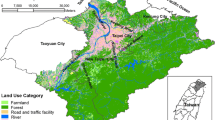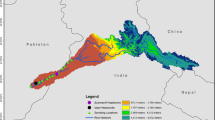Abstract
River cruising ships move along river courses, and thus health risks to passengers may vary spatially due to the accidental exposure of river fecal pollution. This study performed a spatial dynamic assessment of health risks for river cruises in the highly urbanized Tamsui River Basin. First, the spatial distributions of river Escherichia coli (E. coli) were probabilistically characterized using indicator kriging (IK). Moreover, the current river cruise information was surveyed to obtain cruise routes and transit times. Then, to explore the parametric uncertainty of quantitative microbial risk assessment (QMRA), the ingestion rate (IR) for boating was determined using Monte Carlo simulation (MCS). Moreover, river E. coli distributions were estimated using nonparametric MCS according to multi-threshold IK estimates. Eventually, after combining the distribution of the joint probability of the IR and E. coli in QMRA, the β-Poisson dose–response function was adopted to analyze risks to river cruise passengers at discretized segments of cruise routes. Health risks to river cruise passengers were integrated at the discretized segments to explore suitable recreational strategies for river cruises. The research results indicate that all health risks do not exceed a daily target level of 8 illnesses per 1000 exposures for single-trip cruise routes. However, health risks to passengers can exceed this level for round-trip cruise routes along highly polluted urban river courses.







Similar content being viewed by others
References
Brown, T. C., Taylor, J. G., & Shelby, B. (1991). Assessing the direct effects of streamflow on recreation: a literature review. Water Resources Bulletin, 27(6), 979–989.
Chen, Y. C., Yeh, H. C., & Wei, C. (2012). Estimation of river pollution index in a tidal stream using kriging analysis. International Journal of Environmental Research and Public Health, 9(9), 3085–3100.
Chen, S. K., Jang, C. S., & Peng, Y. H. (2013). Developing a probability-based model of aquifer vulnerability in an agricultural region. Journal of Hydrology, 486, 494–504.
Chica-Olmo, M., Luque-Espinar, J. A., Rodriguez-Galiano, V., Pardo-Igúzquiza, E., & Chica-Rivas, L. (2014). Categorical indicator kriging for assessing the risk of groundwater nitrate pollution: the case of Vega de Granada aquifer (SE Spain). Science of the Total Environment, 470–471, 229–239.
Chigor, V. N., Sibanda, T., & Okoh, A. I. (2014). Assessment of the risks for human health of adenoviruses, hepatitis A virus, rotaviruses and enteroviruses in the Buffalo River and three source water dams in the Eastern Cape. Food and Environmental Virology, 6, 87–98.
Department of Transportation, Taipei City Government (DOT-TCG) (2017). River cruise. Department of Transportation, Taipei City Government. http://english.dot.gov.taipei/lp.asp?ctNode=65642&CtUnit=35701&BaseDSD=7&mp=117002. Accessed 25 Oct 2017.
Deutsch, C. V., & Journel, A. G. (1998). GSLIB: geostatistical software library and user’s guide (2nd ed.). New York: Oxford University Press.
Donovan, E., Unice, K., Roberts, J. D., Harris, M., & Finley, B. (2008). Risk of gastrointestinal disease associated with exposure to pathogens in the water of the lower Passaic River. Applied and Environmental Microbiology, 74(4), 994–1003.
Geosyntec. (2008). Dry and wet weather risk assessment of human health impacts of disinfection vs. no disinfection of the Chicago area waterways system (CWS) (pp. 99–110). Chicago: Metropolitan Water Reclamation District of Greater Chicago.
Gerba, C. P., Rose, J. B., Haas, C. N., & Crabtree, K. D. (1996). Waterborne rotavirus: a risk assessment. Water Research, 30(12), 2929–2940.
Goovaerts, P. (1997). Geostatistics for Natural Resources Evaluation (pp. 259–368). New York: Oxford University Press.
Goovaerts, P., Semrau, J., & Lontoh, S. (2001). Monte Carlo analysis of uncertainty attached to microbial pollutant degradation rates. Environmental Science & Technology, 35, 3924–3930.
Goovaerts, P., AvRuskin, G., Meliker, J., Slotnick, M., Jacquez, G., & Nriagu, J. (2005). Geostatistical modeling of the spatial variability of arsenic in groundwater of southeast Michigan. Water Resources Research, 41. https://doi.org/10.1029/2004WR003705.
Haas, C. N. (2015). Microbial dose response modeling: past, present, and future. Environmental Science & Technology, 49(3), 1245–1259.
Haas, C. N., Thayyar-Madabusi, A., Rose, J. B., & Gerba, C. P. (2000). Development of a dose-response relationship for Escherichia coli O157:H7. International Journal of Food Microbiology, 1748, 153–159.
Haas, C. N., Rose, J. B., & Gerba, C. P. (2014). Quantitative Microbial Risk Assessment (2nd ed.) (pp.72–73 and pp.267–321)). New York: Wiley.
Health Canada. (2012). Guidelines for Canadian Recreational Water Quality (3rd ed.p. 26). Ottawa: Water, Air and Climate Change Bureau, Healthy Environments and Consumer Safety Branch, Health Canada.
Jang, C. S. (2016). Using probability-based spatial estimation of the river pollution index to assess urban water recreational quality in the Tamsui River watershed. Environmental Monitoring and Assessment, 188(36), 1–17.
Jang, C. S., & Chen, S. K. (2018). Establishing a spatial map of health risk assessment for recreational fishing in a highly urbanized watershed. Stochastic Environmental Research and Risk Assessment, 32(3), 685–699.
Jang, C. S., & Liang, C. P. (2018). Characterizing health risks associated with recreational swimming at Taiwanese beaches by using quantitative microbial risk assessment. Water Science and Technology, 77(2), 534–547.
Jang, C. S., Liu, C. W., Lin, K. H., Huang, F. M., & Wang, S. W. (2006). Spatial analysis of potential carcinogenic risks associated with ingesting arsenic in aquacultural tilapia (Oreochromis mossambicus) in blackfoot disease hyperendemic areas. Environmental Science & Technology, 40, 1707–1713.
Jang, C. S., Liang, C. P., & Wang, S. W. (2013). Integrating the spatial variability of water quality and quantity to probabilistically assess groundwater sustainability for use in aquaculture. Stochastic Environmental Research and Risk Assessment, 27, 1281–1291.
Juang, K. W., & Lee, D. Y. (1998). Simple indicator kriging for estimating the probability of incorrectly delineating hazardous areas in a contaminated site. Environmental Science & Technology, 32, 2487–2493.
Lee, J. J., Jang, C. S., Wang, S. W., & Liu, C. W. (2007). Evaluation of potential health risk of arsenic-affected groundwater using indicator kriging and dose-response model. Science of the Total Environment, 384, 151–162.
Money, E. S., Carter, G. P., & Serre, M. L. (2008). Improving the assessment of E. coli exposure levels along un-monitored stream reaches. Epidemiology, 19(6), S162–S163.
Money, E. S., Carter, G. P., & Serre, M. L. (2009). Modern space/time geostatistics using river distances: data integration of turbidity and E. coli measurements to assess fecal contamination along the Raritan River in New Jersey. Environmental Science & Technology, 43, 3736–3742.
Prideaux, B., Timothy, D. J., & Cooper, M. (2009). In B. Prideaux & M. Cooper (Eds.), Introducing river tourism: Physical, ecological and human aspects. River tourism (pp. 1–22). Wallingford: CABI Publishing.
Ren, X., Zeng, G., Tang, L., Wang, J., Wan, J., Liu, Y., Yu, J., Yi, H., Ye, S., & Deng, R. (2018a). Sorption, transport and biodegradation – an insight into bioavailability of persistent organic pollutants in soil. Science of the Total Environment, 610-611, 1154–1163.
Ren, X., Zeng, G., Tang, L., Wang, J., Wan, J., Feng, H., Song, B., Huang, C., & Tang, X. (2018b). Effect of exogenous carbonaceous materials on the bioavailability of organic pollutants and their ecological risks. Soil Biology and Biochemistry, 116, 70–81.
Rijal, G., Tolson, J. K., Petropoulou, C., Granato, T. C., Glymph, A., Gerba, C., Deflaun, M. F., O’Connor, C., Kollias, L., & Lanyon, R. (2011). Microbial risk assessment for recreational use of the Chicago area waterway system. Journal of Water and Health, 9(1), 169–186.
Schilling, K. E., Zhang, Y. K., Hill, D. R., Jones, C. S., & Wolter, C. F. (2009). Temporal variations of Escherichia coli concentrations in a large Midwestern river. Journal of Hydrology, 365(1–2), 79–85.
Soller, J. A., Schoen, M. E., Bartrand, T., Ravenscroft, J. E., & Ashbolt, N. J. (2010). Estimated human health risks from exposure to recreational waters impacted by human and non-human sources of faecal contamination. Water Research, 44(16), 4674–4691.
Steyn, M., Jagals, P., & Genthe, B. (2004). Assessment of microbial infection risks posed by ingestion of water during domestic water use and full-contact recreation in a mid-southern African region. Water Science and Technology, 50(1), 301–308.
Sunger, N., & Haas, C. N. (2015). Quantitative microbial risk assessment for recreational exposure to water bodies in Philadelphia. Water Environment Research, 87(3), 211–222.
Taiwan Environmental Protection Administration (Taiwan EPA) (2017). Environmental water quality information. Environmental Protection Administration, Executive Yuan, Taiwan. http://wq.epa.gov.tw/WQEPA/Code/?Languages=en. Accessed 1 Aug 2017.
Till, D., McBride, G., Ball, A., Taylor, K., & Pyle, E. (2008). Large-scale freshwater microbiological study: rationale, results and risks. Journal of Water and Health, 6(4), 443–460.
Tseng, L. Y., & Jiang, S. C. (2012). Comparison of recreational health risks associated with surfing and swimming in dry weather and post-storm conditions at Southern California beaches using quantitative microbial risk assessment (QMRA). Marine Pollution Bulletin, 64(5), 912–918.
U.S. Environmental Protection Agency (U.S. EPA). (1986). Ambient Water Quality Criteria for Bacteria - 1986 (p. 15) (EPA 440-5-84-002)). Washington, DC: U.S. Environmental Protection Agency.
U.S. Environmental Protection Agency (U.S. EPA). (2001). Risk Assessment Guidance for Superfund (RAGS) Volume III - Part A: Process for Conducting Probabilistic Risk Assessment (pp.3–1~3–27). Washington, DC: Office of Emergency and Remedial Response, U.S. Environmental Protection Agency.
U.S. Environmental Protection Agency (U.S. EPA). (2012). Recreational Water Quality Criteria (p. 14) (EPA-820-F-12-058)). Washington, DC: Office of Water, United States Environmental Protection Agency.
U.S. Environmental Protection Agency (U.S. EPA). (2014). Microbiological Risk Assessment (MRA) Tools, Methods, and Approaches for Water Media (pp.90–94 and pp.104–110) (EPA-820-R-14-009). Washington, DC: Office of Science and Technology Office of Water, U.S. Environmental Protection Agency.
Wang, Y. B., Liu, C. W., Liao, P. Y., & Lee, J. J. (2014). Spatial pattern assessment of river water quality: Implications of reducing the number of monitoring stations and chemical parameters. Environmental Monitoring and Assessment, 186(3), 1781–1792.
World Health Organization (WHO). (2003). Guidelines for safe recreational water environments. Vol. 1. Coastal and fresh waters (pp. 82–87). Geneva: World Health Organization.
World Health Organization (WHO). (2016). Quantitative microbial risk assessment: application for water safety management (pp. 171–179). Geneva: World Health Organization.
Yu, W. H., Harvey, C. M., & Harvey, C. F. (2003). Arsenic in groundwater in Bangladesh: A geostatistical and epidemiological framework for evaluating health effects and potential remedies. Water Resources Research, 39(6). https://doi.org/10.1029/2002WR001327.
Acknowledgements
The authors would like to thank the Taiwan Environmental Protection Administration for generously supporting the data on E. coli in the Tamsui River Basin, and the Taiwan Ministry of Science and Technology for financially supporting this research under Contract No. MOST 106-2410-H-424-020.
Funding
This study received financial support from Taiwan Ministry of Science and Technology under Contract No. MOST 106-2410-H-424-020.
Author information
Authors and Affiliations
Corresponding author
Additional information
Publisher’s Note
Springer Nature remains neutral with regard to jurisdictional claims in published maps and institutional affiliations.
Electronic supplementary material
ESM 1
(DOCX 840 kb)
Rights and permissions
About this article
Cite this article
Jang, CS., Liang, CP. & Chen, SK. Spatial dynamic assessment of health risks for urban river cruises. Environ Monit Assess 191, 1 (2019). https://doi.org/10.1007/s10661-018-7122-4
Received:
Accepted:
Published:
DOI: https://doi.org/10.1007/s10661-018-7122-4




